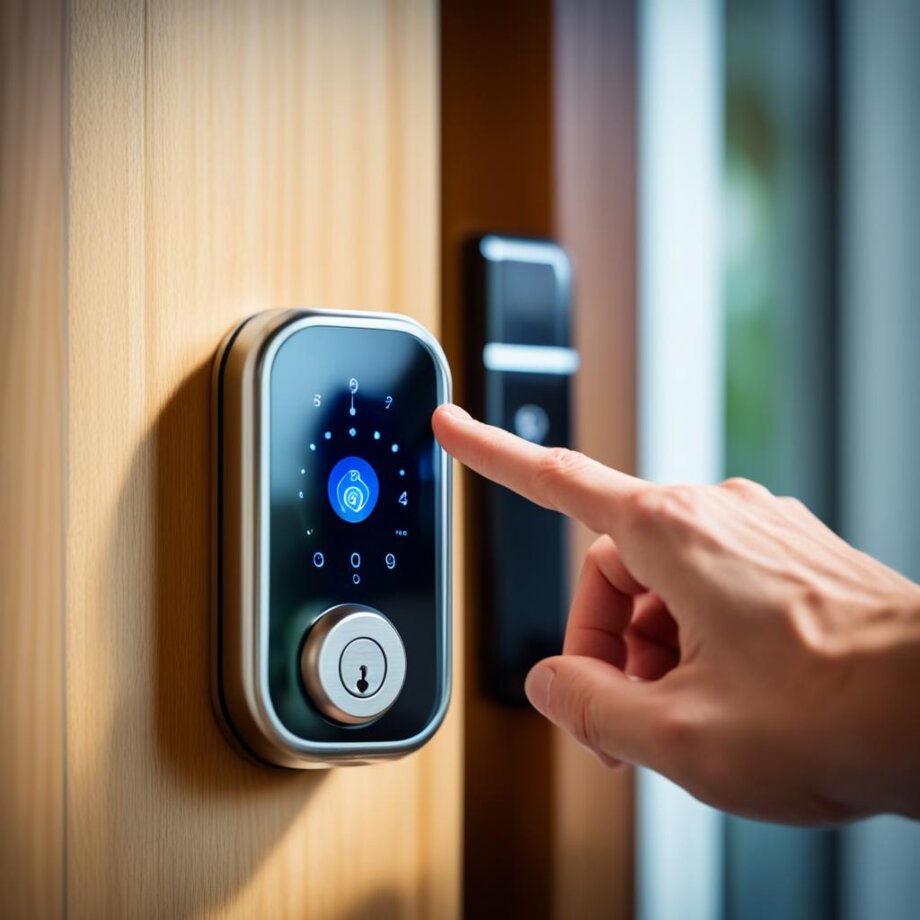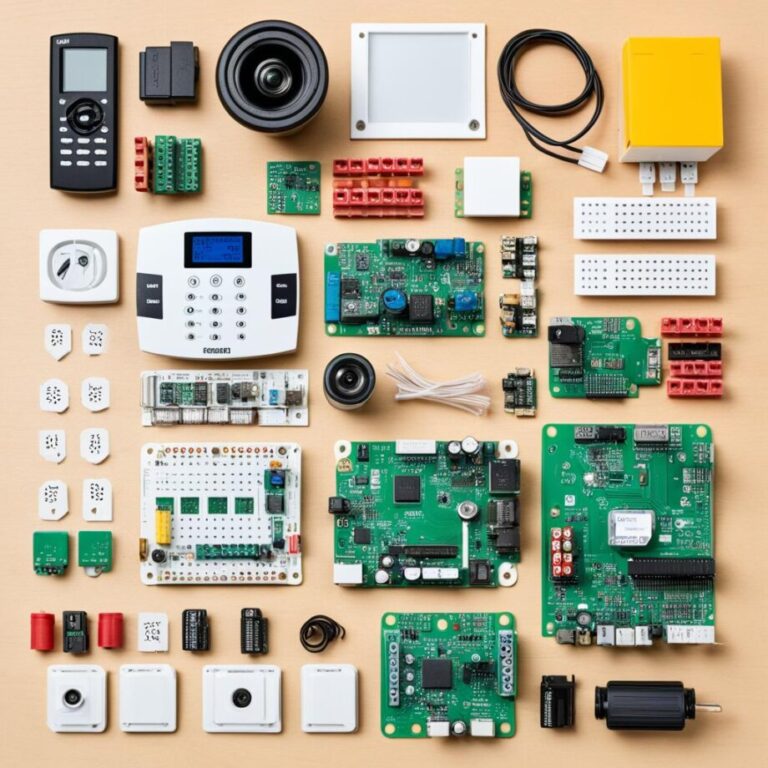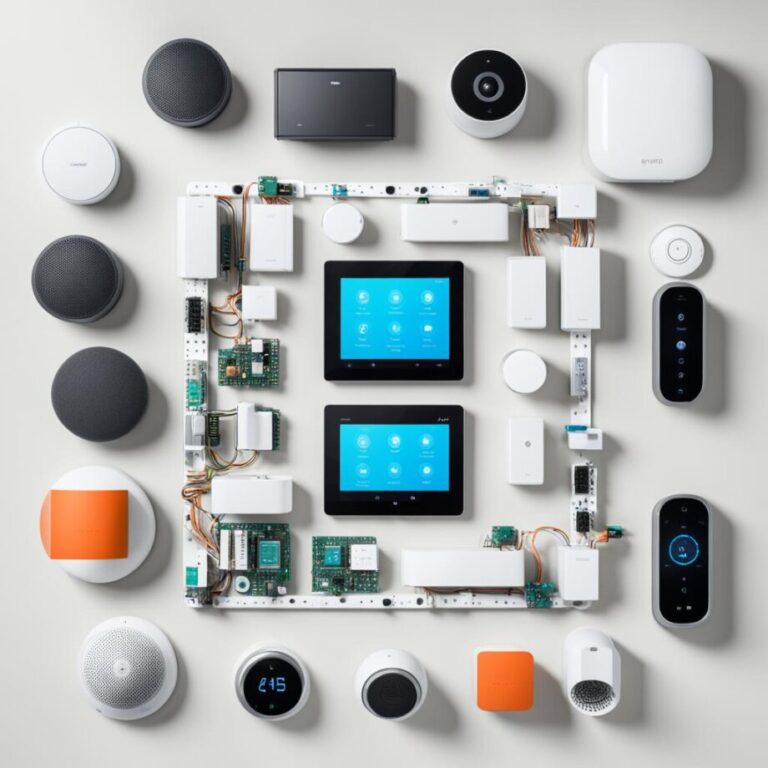Are you tired of fumbling for your keys every time you arrive home? Or maybe you want to add an extra layer of security to your property? With smart locks, you can say goodbye to traditional keys and embrace the convenience of keyless entry. But how exactly do these high-tech devices work, and how can you set them up effortlessly? In this beginner’s tutorial, we will guide you through the process of getting started with smart locks, so you can enjoy the benefits of keyless entry with ease.
Understanding Smart Lock Technology
Before diving into the setup process, it’s important to understand the basics of smart lock technology. In this section, we will provide a comprehensive beginner’s guide to smart lock technology, covering everything from how they work to the different types available.
Smart lock technology revolutionizes home security systems by combining convenience and enhanced protection. Gone are the days of carrying around bulky keychains or worrying about lost keys. With smart locks, you can embrace the future of keyless entry.
How do smart locks work?
Smart locks utilize advanced technology to secure your home while providing seamless access to authorized individuals. Typically, they connect to your smartphone or other smart devices, allowing you to control and monitor your lock remotely.
The most common way smart locks function is through wireless communication, such as Bluetooth or Wi-Fi. By connecting to a compatible app, you can lock and unlock your door using your smartphone, receive real-time notifications, and even grant access to others.
“Smart locks are designed to streamline the access process, making it easier and more secure for homeowners. With features like remote access and user management, smart locks offer a convenient alternative to traditional keys.”
Types of smart locks:
| Smart Lock Type | Description |
|---|---|
| Bluetooth Smart Locks | These locks rely on a direct connection between your smartphone and the lock. They offer simplicity and are suitable for smaller spaces. |
| Wi-Fi Smart Locks | These locks connect to your home’s Wi-Fi network, providing remote access and enabling integration with other smart home devices. |
| Keypad Smart Locks | Keypad smart locks allow users to input a unique PIN code to gain access. They’re ideal for granting temporary access to guests or service providers. |
| Biometric Smart Locks | These locks use fingerprint or facial recognition technology to provide secure access. Biometric smart locks offer advanced security measures. |
Now that you have a basic understanding of smart lock technology, you’re ready to explore the diverse range of smart lock options available. Whether you opt for a Bluetooth, Wi-Fi, keypad, or biometric smart lock, you’ll enjoy the convenience, security, and peace of mind that smart locks bring to your home.
Choosing the Right Smart Lock for Your Needs
Before you can begin the process of smart lock installation and setup, it’s important to choose the right smart lock for your needs. With the increasing popularity of smart home technology, there are numerous options available in the market. To ensure a successful installation and seamless setup, here are some factors to consider:
1. Compatibility
Check if the smart lock you’re interested in is compatible with your existing door and lock system. Different smart locks have varying installation requirements, so it’s crucial to choose one that fits your door’s specifications. Take note of the type of door you have, whether it’s a standard door, a double door, or a specialized door like a glass door or a sliding door.
2. Connectivity Options
Consider the connectivity options that the smart lock offers. Most smart locks can connect to your smartphone via Bluetooth or Wi-Fi, allowing you to control and monitor the lock remotely. Determine if you prefer a lock that connects directly to your phone or if you want a lock that integrates with your smart home hub or voice assistant.
3. Security Features
Ensure that the smart lock you choose has robust security features to protect your home. Look for features such as encryption, two-factor authentication, and tamper alerts. Some locks even offer additional security measures such as built-in alarms or automatic lockouts after a certain number of failed attempts.
4. Installation Complexity
Assess your comfort level with DIY installations and choose a smart lock that aligns with your skill level. Some locks require professional installation, while others are designed for easy DIY setup. Consider the time, effort, and tools needed for installation before making your decision.
5. Brand Reputation and Customer Reviews
Research the reputation of the brand and read customer reviews to gain firsthand insights into the performance and reliability of the smart lock you’re considering. Look for brands that have a track record of quality and customer satisfaction.
By taking these factors into account, you can choose the right smart lock that meets your specific needs and preferences. Let’s move on to the installation process in the next section, where we’ll provide step-by-step guidance on setting up your smart lock.
Step-by-Step Smart Lock Installation Guide
Now that you have chosen the right smart lock, it’s time to install it. Don’t worry if you’re a beginner – setting up your smart lock is easier than you might think. Simply follow these easy steps to ensure a seamless installation process.
- Gather the necessary tools: Before you begin, make sure you have all the tools you need. These typically include a screwdriver, batteries (if required), and any additional components that came with your smart lock.
- Prepare your door: Ensure that your door is properly aligned and in good condition. Remove any existing hardware, such as the old doorknob or deadbolt, before proceeding.
- Attach the mounting plate: Start by attaching the mounting plate to the interior side of your door. Use the provided screws to secure it in place.
- Install the smart lock: Carefully line up the smart lock with the mounting plate, ensuring that it is properly aligned. Secure the lock in place by screwing it onto the mounting plate.
- Connect the wires or batteries: Depending on the type of smart lock you have, you may need to connect wires or insert batteries to power the lock. Refer to the manufacturer’s instructions for guidance.
- Complete setup: Once the physical installation is complete, it’s time to set up your smart lock according to the manufacturer’s instructions. This may involve configuring Wi-Fi settings, creating access codes, or connecting the lock to a smart home hub or app.
Remember to consult the user manual or installation guide provided by your smart lock manufacturer for specific instructions and troubleshooting tips.
Follow these easy steps, and you’ll have your smart lock up and running in no time. Enjoy the convenience and security of keyless entry with your new smart lock!
| Pros | Cons |
|---|---|
| Convenient keyless entry | May require additional components or tools |
| Enhanced security features | Initial setup may take some time |
| User-friendly installation process | Compatibility with existing door hardware may vary |
| Ability to create unique access codes | Power source (batteries or wired) may require regular maintenance |
Connecting Your Smart Lock to Wi-Fi
Once your smart lock is installed, it’s time to unlock its full potential by connecting it to your Wi-Fi network. This step is essential for seamless integration with your smart home ecosystem and accessing remote control features. Follow this beginner-friendly smart lock tutorial to ensure a hassle-free setup process.
- Prepare your Wi-Fi network: Before you begin the smart lock setup, ensure that you have a stable Wi-Fi network available. Check the Wi-Fi signal strength in the area where your smart lock is installed, and consider adding a Wi-Fi range extender if needed.
- Access the smart lock settings: Start by opening your smart lock’s dedicated mobile app, usually available for both iOS and Android devices. If you haven’t downloaded the app yet, head to your device’s app store and search for the app associated with your smart lock brand.
- Connect your smart lock to Wi-Fi: Within the app, navigate to the settings menu and look for the option to connect your smart lock to Wi-Fi. This process may vary depending on the brand and model you have chosen. Typically, you will be prompted to input your Wi-Fi network name (SSID) and password.
- Establish a secure connection: Once you have entered your Wi-Fi network details, your smart lock will attempt to establish a secure connection. This may take a few moments. Ensure that your smartphone or tablet is connected to the same Wi-Fi network during this process to facilitate seamless communication with the smart lock.
- Verify the connection: After the connection is established, you will receive a confirmation message indicating that your smart lock is now connected to your Wi-Fi network. You can perform a quick test by using the mobile app to lock and unlock your smart lock remotely.
With your smart lock now connected to Wi-Fi, you can enjoy the full range of features and convenience it offers. Whether you’re in bed, at work, or away on vacation, you’ll have peace of mind knowing that you can control your smart lock from anywhere using your smartphone or tablet.
“Connecting your smart lock to Wi-Fi is a crucial step in maximizing its functionality. With a secure Wi-Fi connection, you can easily control and monitor your smart lock from anywhere, adding an extra layer of convenience and security to your home.”
Wi-Fi Troubleshooting Tips
Encountering issues during the Wi-Fi setup process is not uncommon. Here are some troubleshooting tips to help you overcome common Wi-Fi connection problems:
- Ensure correct Wi-Fi credentials: Double-check that you have entered the correct Wi-Fi network name (SSID) and password. Pay attention to uppercase and lowercase letters, as they are case-sensitive.
- Move closer to the Wi-Fi router: If you’re experiencing a weak Wi-Fi signal or intermittent connectivity, try moving your smart lock closer to your Wi-Fi router for a stronger connection.
- Restart your Wi-Fi router: Sometimes, restarting your Wi-Fi router can resolve temporary network issues. Simply unplug the router from the power source, wait for a minute, and then plug it back in.
- Update your smart lock firmware: Check if there are any updates available for your smart lock’s firmware within the mobile app. Keeping your smart lock’s firmware up to date can often fix compatibility issues and improve performance.
| Wi-Fi Connection Indicator | Status |
|---|---|
| Steady green or solid blue light | Connected to Wi-Fi |
| Flashing green or blue light | Attempting to establish a connection |
| Steady red or yellow light | No Wi-Fi connection |
Programming Access Codes and User Management
A key benefit of smart locks is the ability to program unique access codes for family members, guests, or service providers. With this feature, you can easily manage who has access to your home at any given time. In this section, we will show you how to program access codes and efficiently manage users.
Programming Access Codes
Programming access codes is a straightforward process that allows you to assign unique codes to individuals who need access to your home. Follow these steps to get started:
- Access your smart lock’s programming mode. Refer to your smart lock’s user manual for instructions specific to your device.
- Select the user for whom you want to create an access code.
- Choose a memorable code for the user. It’s best to choose a code that is easy to remember but not obvious to others.
- Enter the code into the smart lock’s programming interface.
- Save the code and exit the programming mode.
By programming access codes, you can grant temporary or permanent access to individuals as needed. For example, you can create a temporary code for a guest staying at your home or a recurring code for a cleaning service that visits regularly.
Managing Users
Efficient user management is crucial for maintaining control over who can access your home. Here are some tips to help you manage users effectively:
- Create separate access codes for each individual to track their usage.
- Regularly review and update the access codes to ensure the security of your home.
- Disable access codes for users who no longer require access.
- Some smart locks allow you to set schedules for when specific access codes are valid. Utilize this feature to restrict access during certain times.
By diligently managing your smart lock’s users and access codes, you can enhance the security and convenience of keyless entry for your home.
“Smart locks provide the convenience of keyless entry while giving you full control over who can access your home.”
Remote Access and Smart Lock Features
Aside from the convenience of keyless entry, smart locks offer a wide range of features and capabilities that enhance the functionality and security of your home. In this section, we will explore the advanced features of smart lock technology and guide you on how to set up your smart lock.
Remote Access
One of the standout features of smart locks is the ability to remotely control and monitor your lock from anywhere using your smartphone or other connected devices. With remote access, you can:
- Lock and unlock your door: Forgot to lock your door? No problem. With remote access, you can securely lock or unlock your door with just a few taps on your phone, providing you with peace of mind no matter where you are.
- Grant temporary access: Need to let someone into your home while you’re away? Simply send them a temporary access code that expires after a set period. This is perfect for granting access to family members, friends, or service providers.
- Receive real-time notifications: Stay informed about the status of your lock with instant notifications on your smartphone. Know when someone enters or exits your home, allowing you to keep track of who is coming and going.
With remote access, you are always in control of your smart lock, giving you the flexibility and convenience to manage access to your home from anywhere.
Advanced Smart Lock Features
In addition to remote access, smart locks offer a variety of advanced features that further enhance security and convenience:
- Auto-lock: Set your smart lock to automatically lock your door after a specified period. Never worry about forgetting to lock your door again.
- Integration with voice assistants: Some smart locks are compatible with popular voice assistants like Amazon Alexa or Google Assistant, allowing you to control your lock with simple voice commands.
- Activity logs: Keep a record of all lock activities, including when the door was locked or unlocked. Easily review the logs to track access and identify any suspicious activities.
- Integration with smart home systems: Integrate your smart lock with other smart home devices, such as security systems or cameras, to create a comprehensive home automation experience.
Take full advantage of these advanced features to customize your smart lock according to your preferences and lifestyle.
To ensure a successful smart lock setup for beginners, be sure to refer to the manufacturer’s instructions and follow the provided guidelines. Now let’s take a look at a comparison table to help you choose the best smart lock for your needs.
| Smart Lock Model | Features | Price | Rating |
|---|---|---|---|
| Brand A | Remote access, activity logs, integration with voice assistants | $199 | 4.5/5 |
| Brand B | Auto-lock, integration with smart home systems | $229 | 4/5 |
| Brand C | Remote access, activity logs, integration with voice assistants, auto-lock | $249 | 4.8/5 |
Use this table as a starting point to help you compare different smart lock models and make an informed decision based on your specific requirements and budget.
Now that you have a clearer understanding of the advanced features and benefits of smart lock technology, you’re ready to dive into the installation process. In the next section, we will guide you through a step-by-step smart lock installation guide, ensuring a seamless setup.
Troubleshooting Common Smart Lock Issues
Smart locks offer a convenient and secure way to access your home, but like any technology, they can sometimes encounter issues. Don’t worry – we’ve got you covered with some troubleshooting tips to help you resolve common smart lock problems and ensure smooth operation.
1. Battery Drain
A common issue with smart locks is battery drain. If you notice that your smart lock’s battery life is shorter than expected, try the following:
- Replace the batteries with new, high-quality ones.
- Make sure the batteries are properly aligned and securely inserted.
- Check if there are any power-hungry features enabled in the lock’s settings that you can disable to conserve battery life.
2. Connectivity Issues
If your smart lock is experiencing connectivity problems, follow these steps to troubleshoot:
- Ensure that your lock is within range of the Wi-Fi router or hub.
- Reset the lock’s Wi-Fi connection and reconnect it to your network.
- If you’re using a hub, check that it’s working properly and connected to the internet.
- Move any electronic devices that may be interfering with the lock’s signal.
3. Unresponsive Keypad or App
If you’re unable to unlock your smart lock using the keypad or mobile app, try the following troubleshooting steps:
- Ensure that the lock has power and is properly connected.
- Restart the lock by removing and reinserting the batteries.
- Check for any firmware or software updates for your lock and install them if available.
- If using a mobile app, ensure that you have a stable internet connection.
4. Mechanical Malfunctions
In some cases, smart locks may encounter mechanical malfunctions that prevent normal operation. If you’re facing mechanical issues, consider the following:
- Inspect the lock mechanism for any obstructions or debris that may be affecting its performance.
- Ensure that the lock is properly aligned with the door and the latch.
- If the issue persists, contact the manufacturer or a professional locksmith for further assistance.
Remember, troubleshooting common smart lock issues can help you quickly resolve any problems that may arise and ensure your smart lock continues to provide the convenience and security you expect.
“Don’t worry – we’ve got you covered with some troubleshooting tips to help you resolve common smart lock problems and ensure smooth operation.”
Conclusion
In conclusion, the world of smart locks is at your fingertips, and it’s easier than ever to embrace the convenience and security they offer. By following this beginner’s tutorial, you can confidently navigate the setup process and unlock a new level of home protection with keyless entry.
With smart lock technology, you no longer have to fumble with keys or worry about lost or stolen copies. Enjoy the ease of accessing your home with just a tap on your smartphone or a simple voice command.
Experience the future of home security today by selecting the right smart lock for your needs, following the step-by-step installation guide, and connecting it to your Wi-Fi network for remote access. With features like user management and advanced functionality, smart locks provide peace of mind and simplify your everyday life.
Don’t let the fear of the unknown hold you back. Embrace the possibilities of smart lock technology, and embark on your smart lock journey now. Say goodbye to traditional locks and welcome the seamless integration of convenience, security, and peace of mind into your home.






